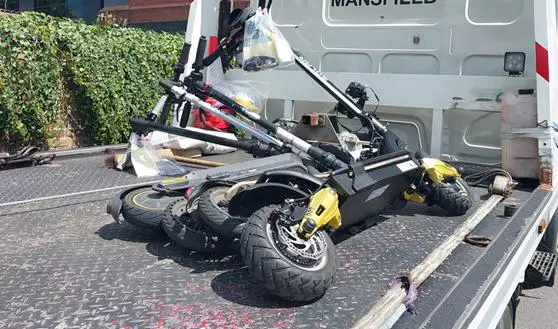From artisanal crepes to rebellious cheesecake waffles, Reading's breakfast rebels are transforming morning meals. These seven spots will revolutionize how you start your day.
In a significant move to address the growing safety concerns surrounding electric scooters and bikes, local police have ramped up their efforts to curb dangerous incidents. Over the past three months, law enforcement officials have seized more than 110 e-scooters and e-bikes, highlighting the increasing prevalence of these vehicles on our streets and the challenges they pose to public safety.
Rising Injuries Prompt Action
This crackdown comes in response to a troubling trend of serious injuries involving e-scooters and e-bikes. As these vehicles gain popularity, authorities are grappling with the need to balance convenient urban mobility with the safety of riders and pedestrians alike. The recent seizures represent a proactive approach by the police to mitigate risks and enforce regulations surrounding the use of these electric vehicles.
Enforcement Efforts Intensify

Over the past three months, local police have seized more than 110 e-scooters and e-bikes in a concerted effort to address safety concerns. This significant number of seizures underscores the scale of the issue and the determination of law enforcement to tackle it head-on. The crackdown comes as a response to a series of serious injuries involving these electric vehicles, highlighting the urgent need for stricter enforcement of existing regulations.
Safety Concerns Take Center Stage
The recent spate of dangerous incidents involving e-scooters and e-bikes has brought safety concerns to the forefront of public discourse. While these vehicles offer convenient urban mobility solutions, their increasing prevalence on streets and sidewalks has led to a rise in accidents and injuries. The police action reflects a growing recognition of the need to balance the benefits of these modes of transport with the safety of all road users, including pedestrians and traditional vehicle operators.
Legal Implications and Public Awareness
The seizure of over 100 electric vehicles raises important questions about the legal status of e-scooters and e-bikes in the area. Many riders may be unaware of the specific regulations governing their use, including where they can be legally operated and what safety equipment is required. This enforcement action serves not only as a deterrent but also as an opportunity to educate the public about the rules and responsibilities associated with using these vehicles.
Community Impact and Reactions
The police crackdown has undoubtedly had a significant impact on the local community. While some residents may welcome the increased enforcement as a necessary step to improve public safety, others might view it as an overreach that limits personal mobility options. The seizure of such a large number of vehicles is likely to spark debates about urban transportation policies and the role of e-scooters and e-bikes in modern city life.
Looking Ahead: Balancing Innovation and Safety
As the situation continues to evolve, local authorities face the challenge of developing comprehensive strategies to address the e-scooter and e-bike phenomenon. The recent police action may serve as a catalyst for discussions about infrastructure improvements, clearer regulations, and public education campaigns. Finding the right balance between embracing innovative transportation solutions and ensuring public safety will be crucial for the community moving forward.
The Path Forward: Integrating E-Mobility Safely
The recent crackdown on e-scooters and e-bikes marks a pivotal moment in the ongoing dialogue about urban transportation. As cities grapple with the rapid influx of these electric vehicles, the need for a comprehensive approach to integration becomes increasingly apparent. This enforcement action serves as a catalyst for broader discussions on how to effectively incorporate e-mobility options into existing transportation networks while prioritising safety.
Collaborative Solutions and Stakeholder Engagement
Moving forward, addressing the challenges posed by e-scooters and e-bikes will likely require collaboration between various stakeholders. Local government officials, transportation planners, e-mobility companies, and community representatives must come together to develop sustainable solutions. This collaborative approach could lead to the creation of dedicated lanes, improved signage, and clearer guidelines for both riders and pedestrians.
Technological Advancements and Safety Features
As the e-mobility industry continues to evolve, technological advancements may play a crucial role in enhancing safety. Future iterations of e-scooters and e-bikes could incorporate advanced safety features such as improved braking systems, better stability controls, and even geofencing capabilities to prevent operation in restricted areas. These innovations could help address some of the safety concerns that prompted the recent police action.
Data-Driven Policy Making
The seizure of over 100 vehicles provides valuable data for policymakers. Analyzing the circumstances surrounding these seizures can inform future regulations and enforcement strategies. By understanding patterns of misuse or areas of frequent incidents, authorities can tailor their approach to maximise safety improvements while minimising disruption to legitimate users.
Long-Term Urban Planning Considerations
The e-scooter and e-bike phenomenon highlights the need for long-term urban planning that accounts for diverse transportation modes. Cities may need to reassess their infrastructure, considering how to safely accommodate these new vehicles alongside traditional modes of transport. This could involve redesigning street layouts, implementing smart traffic management systems, and creating designated parking areas for e-mobility devices.
Public Education and Awareness Campaigns
Lastly, the recent enforcement efforts underscore the importance of public education. Launching comprehensive awareness campaigns can help ensure that both riders and non-riders understand the rules, rights, and responsibilities associated with e-scooters and e-bikes. By fostering a culture of mutual respect and awareness among all road users, communities can work towards a safer, more integrated transportation ecosystem that embraces the benefits of e-mobility while mitigating its risks.